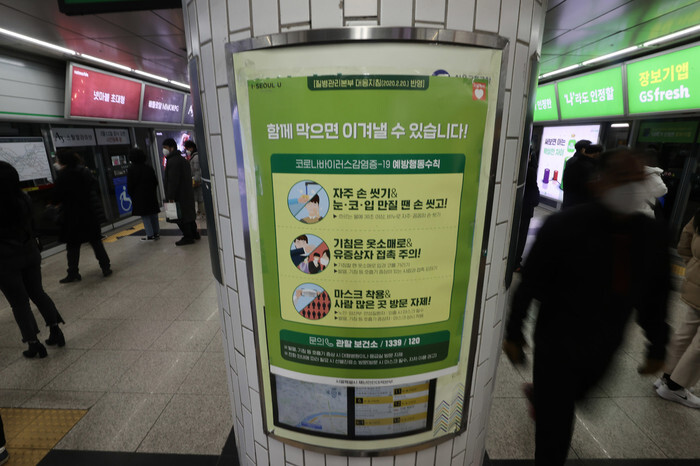hankyoreh
Links to other country sites 다른 나라 사이트 링크
[Editorial] Poor working conditions led to transmission cluster at Guro District call center

The number of diagnosed novel coronavirus cases at a call center in Seoul’s Guro District stood at 102 people as of the morning of Mar. 12. The efforts to stop additional contagion from this cluster appear likely to be a watershed in terms of preventing mass transmission in Greater Seoul. In particular, more stringent and effective measures are urgently needed for high-risk, densely staffed workplaces like call centers.
It has been reported that call center employees began showing symptoms such as sore throats as early as around Feb. 28 but continued working, and that full-scale self-isolation and other measures did not begin until after the first confirmed diagnosis on Mar. 8. An employee at another call center in Daegu reportedly complained of fever symptoms on Feb. 26, but was instructed to work for over an hour after having their temperature taken by their manager. It’s hard to avoid concluding that businesses have been too complacent, especially in light of the heightened sense of alarm about densely population settings since the eruption of the Shincheonji supercluster in Daegu. There is a possibility that poor working conditions -- including cuts to incentives for those not fulfilling sales quotas -- may have resulted in the infectious disease spreading.
South Korea has an estimated 700 to 1,000 call centers alone. Other equally high-risk workplaces include karaoke businesses, internet cafes, and sports centers. In announcing plans on Mar. 11 to develop infection management guidelines for densely populated workplaces -- including the adoption of telecommuting and flexible work systems and adjustments to seating arrangements -- public health authorities also asked that symptomatic employees not be penalized for not reporting to work. We also hope the government will give active consideration to the argument from some quarters that incentives such as tax benefits to companies will be needed for these guidelines to function properly.
The response to this cluster of infections is even trickier because the patients’ residences are located all over Greater Seoul, with a broad radius of activity. The Sindorim and Guro subway stations are transportation hubs used by 110,000 and 20,000 people each day, respectively. Fortunately, the cities of Seoul and Incheon and Gyeonggi Province have announced plans to develop a system of cooperation; hopefully, they will move forward quickly with an epidemiological study. Cooperation is also needed from people who frequently use services in the vicinity, including active reporting of any symptoms such as fever. Experts believe the likelihood of becoming infected through the use of public transportation is lower than the risk with densely populated gatherings. Rather than becoming excessively panicked, it’s time for us to be even more thorough about personal prevention approaches such as washing our hands and not touching our faces in public.
Jung Eun-kyeong, director of the Korea Centers for Disease Control and Prevention (KCDC), said on Mar. 11 that “more aggressive and strenuous measures may be needed if the risk of community infections increases.” As this indicates, the current moment, with isolated clusters of infections appearing one after the other in regions outside of Daegu and North Gyeongsang Province, is a critical moment for the virus’s spread. It’s time for authorities and the public alike to tighten the reins on their disease control efforts.
Please direct comments or questions to [english@hani.co.kr]

Editorial・opinion
![[Editorial] Intensifying US-China rivalry means Seoul must address uncertainty with Beijing sooner than later [Editorial] Intensifying US-China rivalry means Seoul must address uncertainty with Beijing sooner than later](https://flexible.img.hani.co.kr/flexible/normal/500/300/imgdb/original/2024/0517/8117159322045222.jpg) [Editorial] Intensifying US-China rivalry means Seoul must address uncertainty with Beijing sooner than later
[Editorial] Intensifying US-China rivalry means Seoul must address uncertainty with Beijing sooner than later![[Column] When ‘fairness’ means hate and violence [Column] When ‘fairness’ means hate and violence](https://flexible.img.hani.co.kr/flexible/normal/500/300/imgdb/original/2024/0516/7417158465908824.jpg) [Column] When ‘fairness’ means hate and violence
[Column] When ‘fairness’ means hate and violence- [Editorial] Yoon must stop abusing authority to shield himself from investigation
- [Column] US troop withdrawal from Korea could be the Acheson Line all over
- [Column] How to win back readers who’ve turned to YouTube for news
- [Column] Welcome to the president’s pity party
- [Editorial] Korea must respond firmly to Japan’s attempt to usurp Line
- [Editorial] Transfers of prosecutors investigating Korea’s first lady send chilling message
- [Column] Will Seoul’s ties with Moscow really recover on their own?
- [Column] Samsung’s ‘lost decade’ and Lee Jae-yong’s mismatched chopsticks
Most viewed articles
- 1[Editorial] Transfers of prosecutors investigating Korea’s first lady send chilling message
- 2[Exclusive] Unearthed memo suggests Gwangju Uprising missing may have been cremated
- 3[Column] US troop withdrawal from Korea could be the Acheson Line all over
- 4S. Korea “monitoring developments” after report of secret Chinese police station in Seoul
- 5[Editorial] Intensifying US-China rivalry means Seoul must address uncertainty with Beijing sooner t
- 6‘Shot, stabbed, piled on a truck’: Mystery of missing dead at Gwangju Prison
- 7Could Korea’s Naver lose control of Line to Japan?
- 8Xi, Putin ‘oppose acts of military intimidation’ against N. Korea by US in joint statement
- 9US has always pulled troops from Korea unilaterally — is Yoon prepared for it to happen again?
- 10Korea’s first openly trans athlete hopes to prompt a discussion by competing as herself